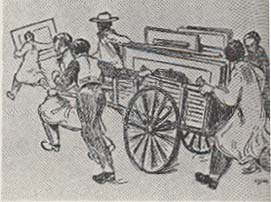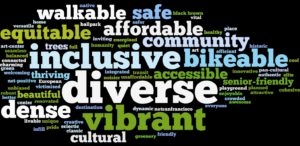
Awesome Charrettes: Part 1- Big Picture
First, what is a charrette?
The historic term comes from French design schools where project would be picked up at midnight in a cart. The candidates for design would be frantically finishing their sketches, riding on the cart, squeezing every last moment in order to complete the work.
 The modern-day charrette comes in different shapes and sizes.
The modern-day charrette comes in different shapes and sizes.
The most intense and design focused is a community charrette, which may take several days with many iterations of design and then feedback from the community stakeholders. The National Charrette Institute lays out ways to conduct these wide and deep meetings and certifies trained facilitators with appropriate skills and experience. See this link for more – http://charretteinstitute.org/
This level of community-focused design brainstorming and guidance can help a difficult project gain support, can build momentum for the process and can build public attention through publicity and sharing of milestone steps. It is also an excellent tool to develop solutions where none are currently obvious or where there are many options available. A community charrette can tackle, for example, solutions to address downtown blight, or to improve the High School, or to define the future of the city parks.
A LEED charrette is a more common, lighter, short session to talk about the credits in the LEED Rating System how to achieve them, and how they interrelate with other gains in the project. The project itself is already defined as far as programmatic scope and budget, perhaps. And this is usually the first kick-off meeting of the design and construction team. It helps the team to understand the process and responsibilities as well as where they can optimize their systems and approaches in synergy. The LEED instrument calls for this process, and it is an attempt to create a foundation for an integrative design approach and early attention to significant design decisions.
The third is a programming or sustainability charrette. Consider this the middle ground in that it deals with a big project goal such as a new hospital, yet the paths to achieving that new hospital design are not yet defined. It is this type of charrette I will explore in my next few blog posts.
We need to step back a bit and remember that LEED is a tool.
First, this programming charrette should not use a LEED checklist to drive the agenda, nor should checklist even be a part of the agenda. If you have been involved in a charrette, you are likely wondering how or even why to conduct one without a checklist. We need to step back a bit and remember that LEED is a tool. Your true goal for the project is not to get a LEED rating, but to build a building that will support the users and mission of the owner. The LEED implement is the tool for achievement of that goal, just as code compliance is a tool to ensure the health and safety of the building users and just as a test is a tool for confirming knowledge retention.
The hardest part about sustainable design is getting people to think iteratively and broadly. Using a checklist only reinforces the bad habits of linear thinking and separate thought processes, and it restricts discussion to just what is on the piece of paper, limiting creativity. To support iterative thinking and a broader understanding of the benefits a building can create we must begin…bigger. Begin by seeking to know the people in the room and their passions. Do not discuss the project right out of the gate, but instead talk about the mission of the organization, the things the participants and the organization wish they could achieve, the reason for building or renovating in the first place. Discuss not just the building but how that specific project relates to the complete life of the business or institution, and the goals for that life. Explore also what restrictions or other items may affect the work, such as state or federal mandates, site qualities, budget parameters and schedule.
Then and only then, start to talk about what can help address those goals, missions, mandates. If the organization has a health mandate, as do hospitals, addiction care facilities or daycare centers, then discuss goals for the building that can support that mission, such as good air quality, non-toxic materials, local foods and fresh, clean water. If it is a business with a retail focus, discuss transportation strategies, employee support, and daylighting for improved buyer experience.
Once these goals are discussed and understood then the priorities can be defined and the proper tools can be identified and then employed for solution building. This is the foundation of a useful charrette.
Next up, some language strategies for engagement.
Jodi
Be the first to like this post (no login required)

